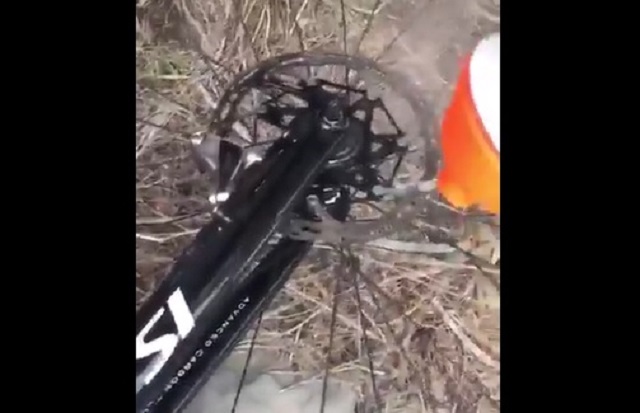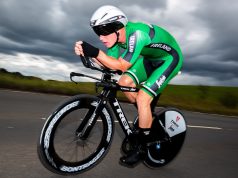Dutch professional rider Reinier Honig (Team Voralberg) has raised a question about the safety of using disc brakes in road races after posting a video showing the heat build-up on the surface of the discs. The video shows Honig pouring water from his bidon directly onto the disc brakes with steam rising from the surface.
Honig who has previously raced for teams including Roompot-Oranje Peloton, Landbouwkrediet and Vacansoleil posted the below video on Twitter, asking the question: “How about this aspect of disc brakes? #hot #ridersafety #nostitchesneeded”
The use of disc brakes raised safety concerns last season when Spanish rider Francisco Ventoso suffered an injury during Paris-Roubaix which he said had been caused when his leg touched the disc brake of a rider in front of him. Ventoso said that Nikolas Maes also suffered a similar injury during the same race.
Ventoso’s concerns prompted the UCI to suspend the use of disc brakes in road races. However in October last year, the sport’s governing body announced that the trial of disc brakes in the peloton would resume this season.
“Following extensive examination of the equipment and a detailed safety report it has been agreed with manufacturers that the trial will restart on January 1st 2017, exclusively with discs which have been modified to ensure the perimeter edge of the brake rotor does not contain any 90-degree edges, but are smoothed or chamfered,” the UCI statement reads.
Honig’s tweet prompted responses from a number of other professionals including Wout Poels of Team Sky who tagged the UCI in his retweet and Lotto-Soudal’s Louis Vervaeke who said: “nice, so now we can fry our eggs on training.”
How about this aspect of disc brakes? #hot #ridersafety #nostitchesneeded pic.twitter.com/MLiThQc6Ug
— Reinier Honig (@ReinierHonig) February 7, 2017










@ReinierHonig Without showing what caused the disc rotor to heat up this proves nothing.
well I hope he doesn’t drive a car, catch a bus or even ride the train… because guess what the same happens there…
Just don’t touch the bloody thing!
That will be tricky in a crash.
It will be tricky not to brake bones and cut yourself during a crash but you don’t stop riding because of it.
If you’re riding fast enough to necessitate braking that hard and then somehow finding yourself coming in contact with a disc, then the hot disc is probably the least of your concerns
Given that cycle racing can already be pretty dangerous, a lot of riders seem to be pretty wimpy when it comes to this disc brake fear. Ventoso’s injury was pretty clearly caused by a chain ring, you could see the teeth marks on his leg and his story of how it happened didn’t add up at all.
Have any of you had a hot disc to the point where it no longer slows you down, it’s fucking scary dropping into a bend at 30mph and not having any brakes.. with this said, I’m still pro disc, just find the best heat expelling ones you can!
And braking technique.
Nothing new, mountain bikers see this all the time….
Maybe they should ban slick tyres as well, since there is virtually no grip on wet or dusty roads. And V-brakes (or cantilevers) should also be eliminated, because the rim gets too hot, causing clincher tyres to burst or tubbies’ glue to melt. And don’t get me started on those ever increasing dangerous, unusable cleats that prevent your feet from unclipping…
Not to mention those slim, sleek saddles, which are more like a surgical instrument than an actual bumrest ….
What about those excuses for helmets !!! AAARRRGGH !!!! From now on, only full face helmets should be allowed, or Adventure type helmets, like the motorcyclists use !
Hitting an object at 80 km/h is going to cause the same amount of damage, regardless if you’re on a bicycle or motorbike.
But we seem to think some lycra and and a carbon plastic dish with holes in it, strapped on our head seems to be sufficient.
From now on, drop bars need to be replaced with BMX handle bars or ape hangers, so that you can see where you’re going, and not where you’ve been.
And those dangerous windy roads they descend on…
The closer to the axle you are, a greater force is required to stop it. Indeed the same applies to get it moving. So greater friction, greater heat. A calliper brake system requires less force to stop the wheel because of its location.
BS. Energy ist the same. Ju just have less material in a disc than in a rim.
There is less surface area. But disc brakes are designed to self cool, unlike rims. It’s a matter of have a bicycle that is built for the ride. For extreme cycling, one needs more extreme (and expensive) parts and equipment. I’m a bike mechanic. I personally favor linear pull (V-Brakes) for recreational and city riding. Only on sport bikes does one need disc brakes, and hydraulic disc for extreme sports.
There is less surface area. But disc brakes are designed to self cool, unlike rims. It’s a matter of have a bicycle that is built for the ride. For extreme cycling, one needs more extreme (and expensive) parts and equipment. I’m a bike mechanic. I personally favor linear pull (V-Brakes) for recreational and city riding. Only on sport bikes does one need disc brakes, and hydraulic disc for extreme sports.
Really! Let’s compare traditional rubber and rim brakes with brake disc hyd tech, then we can have a conversation about your whining.
Post another video when they are red hot. Until then this is nothing to be concerned about.
It’s going to happen, just get on with it.
There’s a 50% chance that the disc will not be on the side of the bike you would land on in the first place!
Then the fork and rear stays are covering part of the disc, so the percentage is further reduced.
If say 15-20% risk is too much for him maybe products cycling is not for him?
Kevin Pretorius
Thanks to Captain Obvious
Disc brakes have been on mtn bikes for years, no issues. As for the video, could do the same on rims after a hard long downhill. Get over it, they work better and aren’t dangerous.
What if…. (sigh).
Here’s a scenario. Don’t use the brakes. They won’t get hot and you’ll go faster.
Did he need a waaambulance?